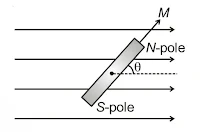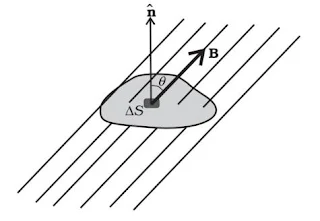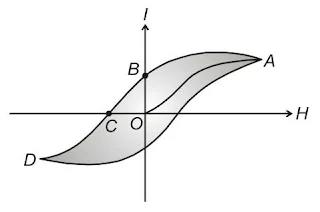Magnetism and Matter Class 12 notes Physics Chapter 5
Introduction
Magnetic phenomena are universal in nature. The science of magnetism grew from the observation that a certain ore could attract small pieces of iron and point in a certain direction when kept on the floating cork. The ore was originally found in the district of Magnesia in Asia Minor (now in western Turkey) and therefore named magnetite.
In this chapter, we shall study about magnetic properties and behaviour of matter.
Bar Magnet
When iron filings are sprinkled on a sheet of glass placed over a short bar magnet, a particular pattern is formed and the following conclusions are drawn
The bar magnet has poles similar to the positive and negative charge of an electric dipole.
One pole is designated as the north pole and the other as the south pole.
When suspended freely, these poles point approximately towards the geographic north and south poles.
Like poles repel each other and unlike poles attract each other.
The poles of a magnet can never be separated.
(i) Magnetic Field Lines
A magnetic field line is an imaginary curve, the tangent to which at any point gives the direction of magnetic field B at that point.
The magnetic field lines of a magnet form a close-continuous loop.
Outside the body of the magnet, the direction of magnetic field lines are from the north pole to the south pole.
No two magnetic field lines can intersect each other. This is because, at the point of intersection, we can draw two tangents. This would mean two directions of the magnetic field at the same point, which is not possible.
The larger the number of field lines crossing per unit area, the stronger the magnitude of the magnetic field B.
Recommended Books
- NCERT Textbook For Class 12 Physics Part 1 & 2
- CBSE All In One Physics Class 12 2022-23 Edition
- Oswaal CBSE Chapterwise Question Bank Class 12 Physics Book
- Modern's abc Plus of Physics for Class-12 (Part I & II)
Read also: Electromagnetic Induction Class 12 Physics Notes Chapter 6
(ii) Coulomb’s Law of Magnetism
Let pole strength of a monopole be qm, then the magnetic force between two isolated poles kept at separation r is
`F\propto\frac{q_{m(1)}\times q_{m(2)}}{r^2}`
`F=\frac{\mu_0}{4\pi}\frac{q_{m(1)}\times q_{m(2)}}{r^2}`
This force will be attractive if one pole is North and the other is South and the force will be repulsive if both poles are of the same type (i.e. North-North or South-South).
(iii) Magnetic Field due to a Monopole
Magnetic field due to monopole at a point is equal to the magnetic force experienced by a unit pole strength if kept at that point.
`B=\frac{\mu_0}{4\pi}\frac{m}{r^2}`
It is away from the pole if it is N-pole and it is towards the pole if it is S-pole.
(iv) Magnetic Dipole Moment of a Bar Magnet
It is equal to the product of any one pole strength and separation between two poles
`M=m\times 2l`
It is directed from South-pole to north-pole.
Read also: Surface Chemistry Class 12 Chemistry Notes Chapter 5
(v) Magnetic Dipole Moment of a Bar Magnet
(A) On axial position
Magnetic field due to N-pole at P.
`B_{1}=\frac{\mu_0}{4\pi}\frac{m}{(r-l)^2}......(1)`
Magnetic field due to S-pole at point P.
`B_{2}=\frac{\mu_0}{4\pi}\frac{m}{(r+l)^2}......(2)`
Net magnetic field at point P.
`B=B_{1}-B_{2}`
`B=\frac{\mu_0}{4\pi}\frac{m}{(r-l)^2}-\frac{\mu_0}{4\pi}\frac{m}{(r+l)^2}`
`B=\frac{\mu_0}{4\pi}m[\frac{(r+l)^{2}-(r-l)^2}{(r^{2}-l^{2})^2}]`
`B=\frac{\mu_0}{4\pi}\frac{m\times 4rl}{(r^{2}-l^{2})^2}`
`B=\frac{\mu_0}{4\pi}\frac{2(m\times 2l)r}{(r^{2}-l^{2})^2}`
`B=\frac{\mu_0}{4\pi}\frac{2M\times r}{(r^{2}-l^{2})^2}`
For short bar magnet r > > l
`B=\frac{\mu_0}{4\pi}\frac{2M}{r^{3}}`
It is along magnetic dipole moment.
Read also: Conceptual Questions for Class 12 Physics Chapter 5 Magnetism and Matter
(B) On normal bisector
Magnetic field due to N-pole.
`B_{1}=\frac{\mu_0}{4\pi}\frac{m}{(r^{2}+l^{2})}......(1)`
Magnetic field due to S-pole.
`B_{2}=\frac{\mu_0}{4\pi}\frac{m}{(r^{2}+l^{2})}......(2)`
From symmetry net field at P will be
`B=B_{1}cos\theta+B_{2}cos\theta`
`B=2[\frac{\mu_0}{4\pi}\frac{m}{(r^{2}+l^{2})}]cos\theta`
`B=\frac{\mu_0}{4\pi}\frac{2m}{(r^{2}+l^{2})}\times\frac{l}{(r^{2}+l^{2})^{1/2}}`
`B=\frac{\mu_0}{4\pi}\frac{M}{(r^{2}+l^{2})^{3/2}}`
For short bar magnet r > > l
`B=\frac{\mu_0}{4\pi}\frac{M}{r^3}`
Torque on a Magnetic Dipole in Uniform Magnetic Field
We know torque of electric dipole in electric field E
`\vec{\tau}=\vec{P}\times\vec{E}`
replacing E by B and P by M, we get torque on magnetic dipole
`\vec{\tau}=\vec{M}\times\vec{B}`
`\vec{\tau}=MB sin\theta`
Work done in Rotating a Magnetic Dipole in Uniform Magnetic Field
Let at an instant dipole is at θ from the magnetic field, then the torque acting on the dipole is
τ = MB sinθ
In order to rotate the dipole against this torque by dθ angle, work is done on it by some external source.
dw = τ dθ
dw = MB sinθ dθ
Work done on dipole to rotate it from initial orientation θ1 to final orientation θ2 is
`w=MB\int_{\teta_1}^{\theta_2} sin\theta`
`w=MB[cos\theta_{1}-cos\theta_{2}]`
Gauss’s Law in Magnetism
This law states that “the surface integral of a magnetic field over a closed surface is zero i.e. the net magnetic flux through any closed surface is always zero”.
`\oint\vec{B}.\vec{dS}=0`
Earth’s Magnetism
The earth’s magnetism was assumed to arise from a very large bar magnet placed deep inside the earth along its rotational axis but the main argument against the theory is that the interior of the earth is too hot to maintain any magnetism.
The pattern of the earth’s magnetic field varies with a position as well as time. This is most affected by the solar wind.
The magnetic field lines of the earth appear the same as a magnetic dipole located at the center of the earth.
The pole near the geographic north pole is called the north magnetic pole and the pole near the geographic south pole is called the south magnetic pole.
Geographic meridian: It is a vertical plane passing through the geographic north-south direction. It contains the longitude circle and axis of rotation of the earth.
Magnetic meridian: It is a vertical plane passing through an N–S line of the freely suspended magnet.
Magnetic Declination
It is the angle between the true geographic north-south direction and the north-south line shown by a compass needle at a place. Its value is more at higher latitudes and smaller near the equator. The declination in India is small.
Magnetic Inclination or Dip
It is the angle between the axis of the needle, (in magnetic meridian) that is free to move about a horizontal axis and horizontal. Thus dip is an angle that the total magnetic field of earth Be makes with the surface of the earth. The angle of dip is maximum δ = 90º at poles. It is zero at the magnetic equator.
Horizontal and Vertical component of Earth Magnetic Field
The component of the earth’s magnetic field Be along horizontal is called horizontal component BH.
`B_{H}=B_{e}cos\delta.....(1)`
The component of earth’s magnetic field along vertical is called vertical component Bv.
`B_{V}=B_{e}sin\delta.....(2)`
Relation Between Horizontal and Vertical Component
Squaring and adding equation (1) and (2), we get
`B_{H}^{2}+B_{V}^{2}=B_{e}^{2}(cos^{2}\delta+sin^{2}\delta)`
`B_{e}=\sqrt{B_{H}^{2}+B_{V}^{2}}`
Dividing equation (2) by (1)
`\frac{B_V}{B_H}=tan\delta`
Magnetisation and Magnetic Intensity
(i) Magnetisation
When a magnetic material is placed in a magnetic field, the induced dipole moment develops in the material. The induced dipole moment per unit volume in the magnetic material is called the intensity of magnetisation or magnetisation density). It is denoted by `\vec{I}` and is a vector quantity. Its direction is the same as the direction of induced dipole moment in the material.
`\vec{I}=\frac{\vec{M}_{Net}}{V}`
Where `\vec{M}_{Net}=`Net induced dipole moment in the material. The unit of intensity of magnetisation `\vec{I}` is A/m.
(ii) Magnetic Intensity
In order to magnetize a magnetic material, it is kept in an external field B0. The ratio of magnetising field to the permeability of free space is called magnetic intensity H.
`\vec{H}=\frac{\vec{B}_0}{\mu_0}`
The unit of magnetic intensity is the same as that of the intensity of magnetisation i.e. A/m.
(iii) Magnetic Susceptibility (`\chi_m`)
It is defined as the “ratio of the magnitude of the intensity of magnetisation |`\vec{I}`| to that of magnetic intensity |`\vec{H}`|”. It is a scalar quantity with no dimension, no unit. The physical significance of magnetic susceptibility is that it is the degree of ease with which a magnetic material can be magnetised. A material with a higher value Xm can easily be magnetised.
`\chi_{m}=\frac{I}{H}`
(iv) Magnetic Permeability (`\mu`)
It is defined as the ratio of the magnitude of total magnetic field (B) inside material to that of the magnitude of magnetic intensity (H)”. It is a scalar quantity. Its unit is Wb/A-m. The physical significance of magnetic permeability is that it measures the extent to which a magnetising field can penetrate or permeate a given magnetic material.
`\mu=\frac{B}{H}`
Relative Permeability (`\mu_r`)
It is the ratio of permeability of a medium to that of permeability of free space.
`\mu_{r}=\frac{\mu}{\mu_0}`
Magnetic Properties of Materials
Curie and Faraday observed that almost all substances have certain magnetic properties. On the basis of the magnetic behaviour of different materials, they divided them into three categories : (i) Diamagnetism; (ii) Paramagnetism; (iii) Ferromagnetism.
(i) Diamagnetism
The substances which have a tendency to move from stronger to weaker part of the external magnetic field is called Diamagnetic substance and this phenomenon is known as Diamagnetism. They develop this tendency because they are feebly magnetized in a direction opposite to that of the external magnetizing field. Ex- bismuth, copper, lead, silicon, nitrogen, water and sodium chloride.
Properties of Diamagnetism
The magnetic field lines are expelled by these substances.
The magnetic field inside diamagnetic substance (B) is less than in free space B0.
The relative permeability of diamagnetic substances is less than one.
Xm is negative for diamagnetic material.
Magnetic susceptibility Xm of diamagnetic substance is independent of temperature.
(ii) Paramagnetism
The substances which get feebly magnetized in the direction of the applied external magnetic field is called paramagnetic substance and this phenomenon is known as Paramagnetism. Therefore they have a tendency to move from the region of the weak magnetic field to a strong magnetic field i.e. they get weakly attracted to a magnet. Ex- Aluminium, sodium, calcium, oxygen and copper chloride.
Properties of Paramagnetism
Magnetic field lines tend to pass through these substances therefore magnetic field inside the substance is more than the outside.
The magnetic field inside paramagnetism substance (B) is greater than in free space B0.
The relative permeability of paramagnetism substance is greater than one.
The magnetic susceptibility of a paramagnetic substance is small and positive.
(iii) Ferromagnetism
The substances which get strongly magnetised when placed in an external magnetic field is called ferromagnetic substance, and this phenomenon is known as ferromagnetism, so they have a strong tendency to move from a region of the weak magnetic field to a strong magnetic field. They get strongly attracted to the magnet. Ex- Iron, cobalt, nickel, alloys like alnico, etc.
Properties of Ferromagnetism
Magnetic field lines tend to crowd into ferromagnetic material.
The permeability of ferromagnetic materials is very large, of the order of hundreds and thousands.
Magnetic susceptibility Xm of ferromagnetic substances is very high, therefore, they can be magnetized easily and strongly.
With the rise in temperature, the susceptibility of ferromagnetic materials decreases. At a certain temperature ferromagnetic substance is converted into paramagnetic substance. This transition temperature is called Curie temperature or Curie point TC.
Curie’s Law
The magnetic susceptibility of a paramagnetic substance is inversely proportional to absolute temperature T.
`\chi_{m}\propto\frac{1}{T}`
`\chi_{m}=\frac{C}{T}`
The constant C is called Curie’s constant.
Curie-Weiss law
At temperature above the Curie temperature, a ferromagnetic substance becomes an ordinary paramagnetic substance whose magnetic susceptibility obeys the Curie-Weiss law according to which
`\chi_{m}=\frac{C}{T-T_c}`
Hysteresis
When the intensity of magnetisation (I) of ferromagnetic substances is plotted against magnetic intensity for a complete cycle of magnetisation and demagnetisation the resulting loop is called hysteresis loop.
When the intensity of magnetising field (H) is increased, the intensity of magnetisation increases because more and more domains are aligned in the direction of the applied field.
When all domains are aligned, the material is magnetically saturated. Beyond this, if the intensity of magnetizing field (H) is increased, the intensity of magnetisation (I) does not increase.
The value of the intensity of magnetisation (I) left in the material at H = 0, is called retentivity or remanence.
Now if magnetizing field is applied in the reverse direction and its intensity H is increased, the material starts de-magnetising. The value of magnetising field needed to reduce magnetisation to zero is called coercivity (OC).
As the reverse magnetising field is increased further, the material again becomes saturated. Now, if the magnetising field is reduced after attaining the reverse saturation, the cycle repeats itself.
The area enclosed by the loop represents a loss of energy during a cycle of magnetisation and demagnetisation.
Hard and Soft Magnets
(i) Hard Magnets
The ferromagnetic material which retains magnetisation for a long period of time is called hard magnetic material or hard ferromagnets. Some hard magnetic materials are Alnico (an alloy of iron, aluminum, nickel, cobalt, and copper) and naturally occurring lodestone. They are used for permanent magnets. Permanent magnet material should have high retentivity and high coercivity.
(ii) Soft Magnets
The ferromagnetic material which retains magnetisation as long as the external field persists is called soft magnetic materials or soft ferromagnets. Soft ferromagnets are soft iron. Such material is used for making electromagnets. For electromagnets, the material should have low retentivity and low coercivity. Electromagnets are used in electric bells, loudspeakers, and telephone diaphragms.
Permanent Magnets and Electromagnets
(i) Permanent Magnets
The substances which at room temperature retain their magnetisation for a long period of time are called Permanent magnets. Permanent magnets should have (a) high retentivity and (b) high coercivity. As the material, in this case, is never put to cyclic changes of magnetization, hence hysteresis is immaterial. From the viewpoint of these facts, steel is more suitable for the construction of permanent magnets than soft iron. The fact that the retentivity of iron is little greater than that of steel is outweighed by the much smaller value of its coercivity.
(ii) Electromagnets
An electromagnet is a temporary strong magnet and is just a solenoid with its winding on a soft iron core which has high permeability and low retentivity.
Summary
Permanent magnets are used in audio speakers, DC motors, Galvanometers, car starters, and such rotating instruments.
The line joining the two poles of a magnet is called the magnetic axis and the vertical plane passing through the axis of a freely suspended or pivoted magnet is called a magnetic meridian.
Michael Faraday introduced the concept of lines of force. His concept is that a line of force is an imaginary curve the tangent to which at a point gives the direction of the field at that point.
Magnetic lines of force are closed curves. Outside a magnet, lines of force are from north to south pole, while inside from south to north.
When a soft iron ring is placed in a magnetic field, no lines pass through the space inside the ring. This phenomenon is called “magnetic screening” or “Shielding”.
Earth has a dipole moment of about 8 × 1022 joule/tesla located at its center.
Electromagnets should have (a) high initial permeability (b) low hysteresis loss and (c) maximum magnetic induction B with a comparatively small value of the magnetizing field.
Permanent magnets should have (a) high retentivity and (b) high coercivity.
The choice of Magnetic materials for different uses can be decided from the hysteresis curve for a specimen of the material.
Coercivity is a measure of the magnetic intensity required to destroy the residual magnetism of the specimen.
Retentivity of a specimen is a measure of the magnetic flux remaining in the specimen when the magnetizing force is removed.
Coercivity is less for soft materials than for hard materials. The higher the coercivity more permanent is the magnet.
Retentivity is greater for soft materials than for hard materials. Higher the retentivity, the stronger the magnet.
Permeability is greater for soft materials than for hard materials. The susceptibility is greater for soft materials than for hard materials.
Isoclinic lines are lines drawn through different places having the same dip. The line joining places of zero dip is called aclinic lines (or magnetic equator).
Isodynamic lines are the lines on the earth’s surface connecting places at which the magnetic intensity is the same.
The intensity of magnetizing force field (`\vec{H}`): It is the ratio of the magnetic field to the permeability of that medium and its value is independent of the medium. `\vec{H}` = `\vec{B}`/`\vec{μ}` It’s SI unit is ampere per meter and cgs unit is oersted.
Relative permeability (μr): It’s the ratio of permeability of medium inside and outside. It’s a number. μr = μ/μ0.
Magnetic Susceptibility (χm) is the ratio of the magnitude of the intensity of magnetization (I) to that of magnetizing field (H). χ = I/H. It’s a scalar and a number. The higher the value of χ, the easier it is to magnetize the substance.
Diamagnetic substances get weakly magnetized in a direction opposite to the magnetizing field.
Paramagnetic substances get weakly magnetized in the direction of magnetizing field.
Manganese (Mn) is the most paramagnetic Substance.
Ferromagnetic Substances: These substances when placed in a magnetizing field get strongly magnetized in the direction of the field.









